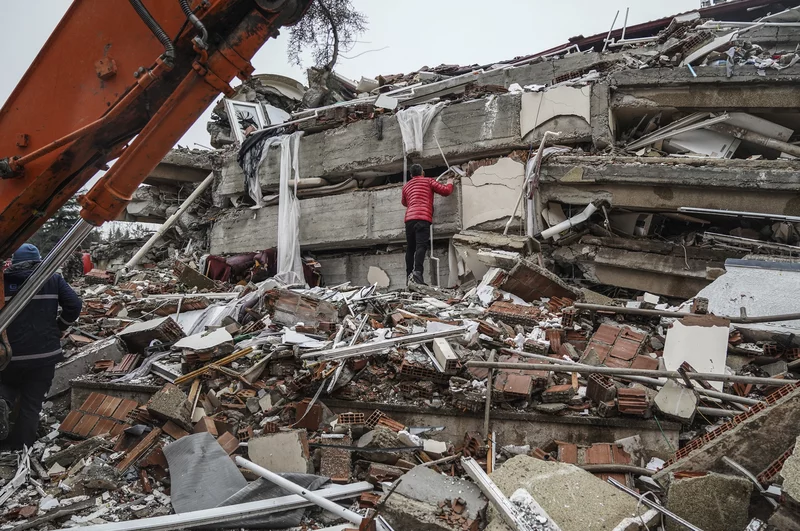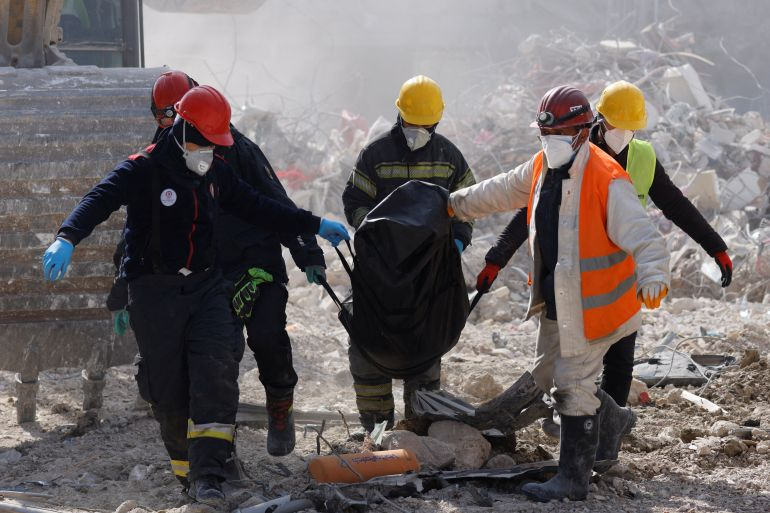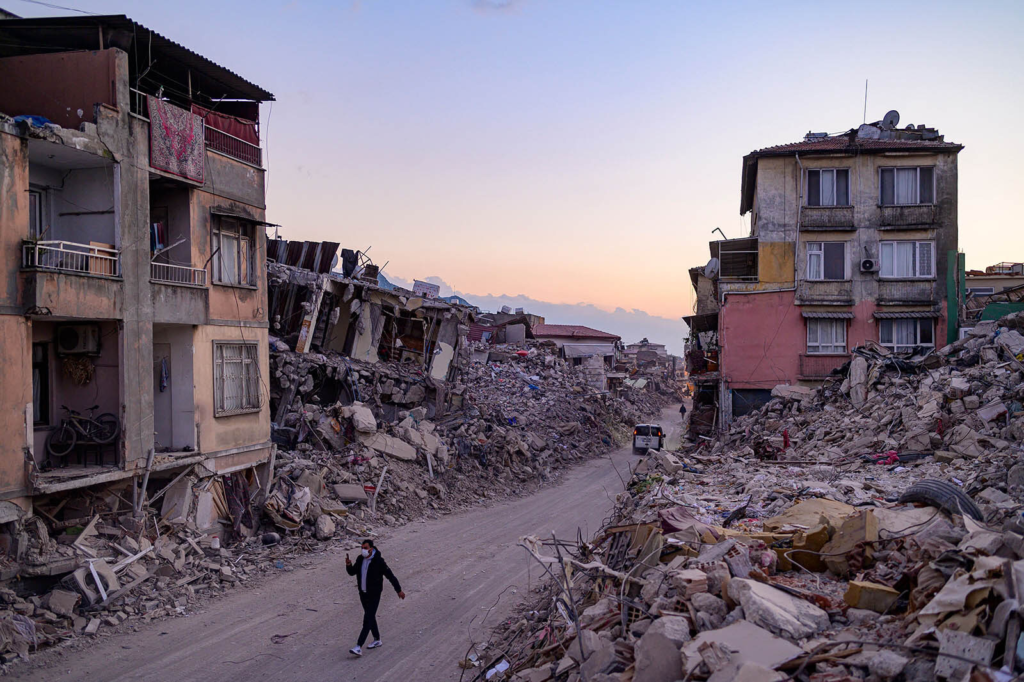Table of Contents
The Turkey Syria Earthquake 2023 was a catastrophic event that shook the world on February 6, 2023. The earthquake, with a magnitude of 7.8, struck southern and central Turkey. It also affected northern and western Syria, causing widespread devastation and loss of life eventually. In fact, this earthquake was one of the deadliest natural disasters in modern history. Moreover, it claimed the lives of 59,259 individuals and injuring 121,704 others.
Background
Complex geology and tectonic activity make the region where the earthquake occurred well-known. Three tectonic giants, the Arabian, African, and Eurasian plates, meet at this location. Furthermore, it makes itself highly susceptible to seismic activity. The earthquake was caused by the movement of the Dead Sea Transform fault, the East Anatolian Fault, and the Çardak–Sürgü Fault.
Aftermath – Turkey Syria Earthquake 2023
The aftermath of the earthquake was characterized by extensive damage, with an estimated total cost exceeding US$118.8 billion. Consequently, the earthquake left thousands of people homeless and caused significant damage to infrastructure, including hospitals, schools, and homes. The Turkish and Syrian governments, along with international aid organizations, launched a massive relief effort. Its aim was to provide assistance to those affected by the earthquake.
Central Argument
The Turkey Syria Earthquake 2023 serves as a stark reminder of the devastating impact of natural disasters. Moreover, it also reminds of the urgent need for global action to address climate change. This article argues that the world must take immediate and decisive action to mitigate the effects of climate change. Furthermore, it also highlights the cause to prevent future disasters like the Turkey Syria Earthquake 2023 from occurring. This earthquake is one of the many natural disasters exacerbated by climate change, as detailed in our Climate Change Report. The article will explore the root causes of climate change. Its impact on the environment and human life. The steps that individuals, governments, and organizations can take to address this critical issue subsequently.
What Caused the Turkey Syria Earthquake 2023?

The Turkey-Syria quake destruction was triggered by the movement of the Arabian and Anatolian plates along the Dead Sea Transform fault system. The Arabian Plate is moving northwards into Europe. Furthermore, it is causing the Anatolian Plate (which Turkey sits on) to be pushed out westwards. This movement of tectonic plates builds up pressure on fault zones at their boundaries, leading to earthquakes and ground shaking.
The earthquake had a magnitude of 7.8 and struck southern and central Turkey, as well as northern and western Syria. Furthermore, the epicenter was located 37 km (23 mi) west-northwest of Gaziantep. Markedly, the earthquake lasted for approximately 80 seconds. Moreover, the depth of the earthquake was 10.0 km (6 mi). In fact, the fault system involved in the earthquake includes the Dead Sea Transform, East Anatolian Fault, and Çardak–Sürgü Fault. Above all, the earthquake was characterized as a strike-slip, supershear, doublet type.
The earthquake generated seismic waves that propagated through the Earth’s crust, resulting in ground shaking. As a matter of fact, the peak ground acceleration (PGA) reached 2.212 g. Moreover, the maximum intensity was XII (Extreme) around the epicenter and in Antakya. In addition, the earthquake produced a tsunami with a height of 17 cm (6.7 in). Subsequently, the Turkey Syria Earthquake 2023 was followed by more than 30,000 aftershocks in the three months that followed.
These seismic waves and ground shaking caused extensive damage in an area of about 350,000 km² (140,000 sq mi), roughly the size of Germany. Eventually, the earthquake resulted in a total damage cost estimated to be over US$118.8 billion. The earthquake’s impact was felt far beyond the epicenter, reaching as far as Egypt and the Black Sea coast of Turkey.
How Did the Earthquake Damage Affect People and Nature?

The earthquake that struck Turkey and Syria caused widespread damage and destruction to buildings, infrastructure, and lifelines in the affected regions. The human toll of the earthquake was immense, with thousands of deaths, injuries, missing persons, displacement, and psychological trauma. The environmental and economic effects of the earthquake were also significant, including landslides, fires, floods, power outages, communication disruptions, and losses.
The earthquake’s aftermath revealed the presence of toxic asbestos in the rubble, posing a serious health risk to residents. The toxic asbestos can lead to cancer, including the lethal mesothelioma. The rubble also contains hazardous materials that further complicate the recovery process.
The earthquake had a profound impact on the region, affecting the lives of countless individuals and causing extensive damage to the environment and economy. The recovery and rebuilding efforts will require significant resources and support from local and international communities.
How Did People Respond to and Recover from this Earthquake?

In the aftermath of the devastating earthquake in Turkey and Syria, various stakeholders, including local authorities, national governments, international organizations, and civil society, mobilized to provide emergency relief and assistance to the affected areas. Their collective efforts aimed to alleviate the suffering of survivors and facilitate the recovery process.
Local authorities played a crucial role in coordinating immediate response efforts. They worked tirelessly to rescue survivors, provide medical aid, and establish temporary shelters for displaced individuals. National governments, recognizing the scale of the disaster, deployed resources and personnel to support relief operations. They facilitated the distribution of essential supplies, including food, water, and medical equipment.
International organizations, such as the United Nations and humanitarian agencies, collaborated with local and national authorities to coordinate relief efforts and provide additional resources. These organizations leveraged their expertise and global networks to mobilize funds, supplies, and personnel to the affected regions. Their involvement was instrumental in ensuring a coordinated and effective response.
However, responders and survivors faced numerous challenges and obstacles throughout the recovery process. Harsh weather conditions, including heavy rain and snowfall, hampered relief operations and hindered access to remote areas. The lack of resources, including medical supplies, clean water, and temporary shelters, posed significant challenges to relief efforts. Security issues, such as the risk of aftershocks and the presence of hazardous materials in the rubble, further complicated the situation.
Impact of Response and Recovery Efforts
Despite these challenges, the response and recovery efforts demonstrated remarkable resilience, innovation, solidarity, and preparedness. Communities came together to support one another, providing assistance to those in need and fostering a sense of unity. Local organizations and volunteers played a critical role in facilitating relief operations and ensuring the well-being of survivors. Lessons learned from previous disasters were applied, leading to improved coordination and response strategies. These best practices will serve as valuable references for future disaster management and preparedness initiatives.
The response and recovery process following the earthquake in Turkey and Syria highlight the importance of collaboration, resource mobilization, and community engagement in mitigating the impact of such disasters. By working together, stakeholders can build more resilient communities and enhance their ability to respond effectively to future crises.
What Can We Learn from this Earthquake?

The devastating earthquake that struck Turkey and Syria has revealed significant gaps and weaknesses in disaster risk management policies and practices in both countries. The scale of the disaster and its impact on communities already suffering from long-term conflict have underscored the need for more robust and comprehensive approaches to earthquake preparedness, prevention, mitigation, and response.
The earthquake has highlighted the importance of improving building codes and infrastructure to withstand seismic events. It has exposed vulnerabilities in existing structures and emphasized the need for stricter regulations and enforcement to ensure the safety of buildings and critical infrastructure. Enhancing the resilience of buildings and lifelines can significantly reduce the impact of future earthquakes.
Recommendations and Actions
To address these challenges, various stakeholders have taken or planned several recommendations and actions to improve earthquake risk reduction in Turkey and Syria. These include:
- Strengthening disaster preparedness and response: Governments and humanitarian organizations are working to enhance early warning systems, emergency response capabilities, and coordination mechanisms. This involves investing in advanced technologies, training first responders, and conducting regular drills and simulations.
- Improving public awareness and education: Raising awareness about earthquake risks and promoting preparedness measures among the general public is crucial. Governments and organizations are implementing public education campaigns, disseminating information through various channels, and conducting community-based training programs.
- Enhancing regional cooperation: The earthquake has highlighted the importance of regional collaboration and knowledge sharing. Countries prone to earthquakes can learn from each other’s experiences, exchange best practices, and develop joint initiatives to strengthen earthquake risk reduction efforts.
- Investing in research and innovation: Governments, academic institutions, and international organizations are investing in research and innovation to develop new technologies, tools, and methodologies for earthquake risk assessment, monitoring, and early warning. These advancements can significantly improve disaster preparedness and response.
While there are significant opportunities for enhancing earthquake risk reduction, several challenges remain. These include limited resources, political instability, and the complex nature of regional conflicts. Overcoming these challenges requires sustained commitment, collaboration, and investment from local, national, and international stakeholders.
By learning from the experiences of other countries and implementing evidence-based practices, Turkey and Syria can strengthen their disaster risk management policies and practices, reduce vulnerabilities, and enhance their resilience to future earthquakes.
What Is the Future Outlook for Turkey and Syria after this Earthquake?

The devastating earthquake that struck Turkey and Syria has had a profound impact on the social, economic, political, and environmental outlook of both countries. The earthquake has changed the lives of millions of people and has posed significant challenges to their recovery and development.
Socially, the earthquake has caused immense suffering and loss. Thousands of lives were lost, leaving families and communities devastated. The survivors have had to cope with the trauma of losing loved ones, displacement, and the destruction of their homes and livelihoods. The earthquake has also strained social services and support systems, making it difficult for affected individuals to access essential resources and assistance.
Economically, the earthquake has resulted in substantial damage to infrastructure, industries, and businesses. The cost of rebuilding and restoring critical infrastructure is estimated to exceed $100 billion. The earthquake has disrupted economic activities, leading to job losses, reduced productivity, and increased poverty and inequality. The recovery and reconstruction efforts will require significant investments and resources to revive the affected regions’ economies.
Politically, the earthquake has highlighted the need for effective governance, coordination, and disaster management systems. The response to the earthquake has exposed gaps and weaknesses in disaster risk management policies and practices. Governments and authorities have faced challenges in providing timely and adequate relief and assistance to affected communities. The earthquake has underscored the importance of strengthening disaster preparedness, response, and recovery mechanisms to mitigate the impact of future seismic events.
Environmentally, the earthquake has caused significant damage to natural resources and ecosystems. The destruction of forests, landslides, and soil erosion have disrupted ecological balance and increased the risk of environmental degradation. The recovery and rebuilding efforts must prioritize sustainable practices to minimize further harm to the environment and promote long-term ecological resilience.
Opportunities and Challenges
The future outlook for Turkey and Syria after this earthquake is characterized by both opportunities and challenges. The recovery and development process will require sustained commitment, collaboration, and investment from local, national, and international stakeholders. The uncertainties and risks associated with seismic hazards, climate change, and ongoing conflicts pose significant challenges to the progress toward resilience and sustainability. However, the earthquake has also provided an opportunity to rebuild stronger, more resilient communities and infrastructure that can withstand future seismic events.
By learning from the lessons of this earthquake and implementing evidence-based practices, Turkey and Syria can enhance their disaster risk management policies, improve infrastructure resilience, and promote sustainable development. The international community’s support and cooperation will be crucial in facilitating the recovery and rebuilding efforts and ensuring the well-being of affected communities.
Final Words
The Turkey-Syria quake of 2023 was one of the most devastating natural disasters in recent history. It caused massive damage and suffering to millions of people in both countries and significant environmental and economic losses. The earthquake exposed the gaps and weaknesses in disaster risk management policies and practices, highlighting the need for more regional cooperation and learning on earthquake risk reduction.
However, the earthquake also demonstrated the resilience and solidarity of the affected communities, as well as the innovation and preparedness of the responders. It created an opportunity for recovery and development that is more sustainable, equitable, and resilient to future shocks. To achieve this, it is essential to implement the recommendations and actions suggested by the earthquake insights and support further research and action on earthquake avoidance and earthquake readiness.
The Turkey-Syria quake prospects depend on how we respond to this challenge and how we learn from this catastrophe. By working together, sharing knowledge, and implementing evidence-based practices, we can build more resilient communities, enhance disaster risk management, and reduce vulnerabilities to future earthquakes.
Let us remember the strength and resilience of the affected communities and strive to create a future that is better prepared, more sustainable, and more compassionate.



